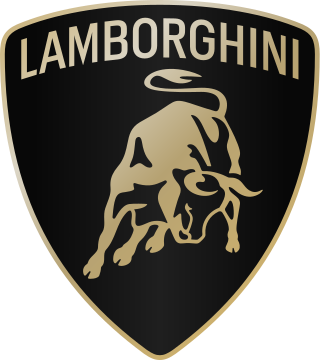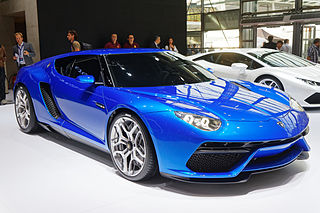
Automobili Lamborghini S.p.A., usually referred to as Lamborghini or colloquially Lambo, is an Italian manufacturer of luxury sports cars and SUVs based in Sant'Agata Bolognese. The company is owned by the Volkswagen Group through its subsidiary Audi.

Monocoque, also called structural skin, is a structural system in which loads are supported by an object's external skin, in a manner similar to an egg shell. The word monocoque is a French term for "single shell".

The mechanical structure of an aircraft is known as the airframe. This structure is typically considered to include the fuselage, undercarriage, empennage and wings, and excludes the propulsion system.

The Lamborghini Gallardo is a sports car built by the Italian automotive manufacturer Lamborghini from 2003 to 2013. It is Lamborghini's second car released under parent company Audi, and the best-selling model at the time with 14,022 built throughout its production run. Named after a famous breed of fighting bull, the V10 powered Gallardo has been Lamborghini's sales leader and stable-mate to a succession of V12 flagship models—first to the Murciélago, then to the Aventador, being the first entry-level Lamborghini in one-and-half decades. On 25 November 2013, the last Gallardo was rolled off the production line. The Gallardo was replaced by the Huracán in 2014.

Carbon fibre reinforced carbon (CFRC), carbon–carbon (C/C), or reinforced carbon–carbon (RCC) is a composite material consisting of carbon fiber reinforcement in a matrix of graphite. It was developed for the reentry vehicles of intercontinental ballistic missiles, and is most widely known as the material for the nose cone and wing leading edges of the Space Shuttle orbiter. Carbon-carbon brake discs and brake pads have been the standard component of the brake systems of Formula One racing cars since the late 1970s; the first year carbon brakes were seen on a Formula One car was 1976.
Dr. Ramulu Mamidala is a mechanical engineering professor at University of Washington. Usually goes by the name 'Ram', or 'M.R.', he is recognized for his leadership and outstanding record in promoting collaborative education and research with industry. He is currently the director of Manufacturing Science and Technology Laboratory (MSTL) at Mechanical Engineering Department, University of Washington. He has designed and developed manufacturing methods for a wide range of systems, from the B2 bomber to the Boeing 787. Additionally, in collaboration with industry, he established and directed two interdisciplinary graduate educational programs in engineering and management and a certificate program in composites tooling and manufacturing. His exemplary collaborative efforts motivated working engineers to pursue doctoral studies and he is a leader in using emerging technologies in distance education to reach non-traditional students.
Carbon fiber-reinforced polymers, carbon-fibre-reinforced polymers, carbon-fiber-reinforced plastics, carbon-fiber reinforced-thermoplastic, also known as carbon fiber, carbon composite, or just carbon, are extremely strong and light fiber-reinforced plastics that contain carbon fibers. CFRPs can be expensive to produce, but are commonly used wherever high strength-to-weight ratio and stiffness (rigidity) are required, such as aerospace, superstructures of ships, automotive, civil engineering, sports equipment, and an increasing number of consumer and technical applications.

The Lamborghini Sesto Elemento is a high-performance limited edition car produced by the Italian automobile manufacturer Lamborghini, which debuted at the 2010 Paris Motor Show. The Sesto Elemento's name is a reference to the atomic number of carbon, referring to the carbon fibre used in its construction.

The Lamborghini Aventador is a mid-engine, two passenger sports car manufactured and marketed by Lamborghini from 2011 until 2022. Named after a prominent Spanish fighting bull that fought in Zaragoza, Aragón, in 1993, the Aventador succeeded the Murciélago and was manufactured in Sant'Agata Bolognese, Italy.
Forged composite, commonly referred to as forged carbon, is a type of carbon fiber SMC material composed of small pieces of carbon fiber composite material that are pressed into shape as the resin sets. This is in contrast to most carbon fiber composites, which are made of larger continuous layers that are 'laid up' one at a time, often manually. Forged composite allows for a higher range of shapes to be formed with precision, relative to traditional carbon fiber. It was originally developed jointly between Lamborghini, Callaway Golf Company, and the Lamborghini Lab. It was unveiled at the 2010 Paris Motor Show in a Lamborghini concept car, the Sesto Elemento. The United States trademark for forged composite was filed on July 13, 2010, in the category Toys and Sporting Goods Products by Callaway Golf, while the trademark for Forged Composites was registered in 2018 in the automotive category by Lamborghini.

The Lamborghini Huracán is a sports car manufactured by Italian automotive manufacturer Lamborghini replacing the previous V10 offering, the Gallardo. The Huracán was revealed online in December 2013, making its worldwide debut at the 2014 Geneva Auto Show and was released in the market in the second quarter of 2014.

Automobili Lamborghini S.p.A. is an Italian brand and manufacturer of luxury automobiles. Lamborghini's production facility and headquarters are located in Sant'Agata Bolognese, Italy. Italian manufacturing magnate Ferruccio Lamborghini founded the company in 1963 with the objective of producing a refined grand touring car to compete with offerings from established marques such as Ferrari. The company's first models were introduced in the mid-1960s and were noted for their refinement, power and comfort. Lamborghini gained wide acclaim in 1966 for the Miura sports coupé, which established rear mid-engine, rear wheel drive as the standard layout for high-performance cars of the era.

The Lamborghini Asterion LPI 910-4 is a concept hybrid car manufactured by Italian automobile manufacturer Lamborghini, which was unveiled at the 2014 Paris Motor Show. The car is named after a Minotaur called Asterion and was to be Lamborghini's first hybrid model. The half man – half bull Minotaur was chosen keeping in mind Lamborghini's tradition of naming their cars after a bull while alluding to its usage of different modes of power.

Paolo Feraboli is a carbon fiber technology inventor and businessman. He is the founder and CTO of Gemini Composites, LLC, a wholly owned subsidiary of Mitsubishi Chemical Carbon Fiber and Composites, and founder and former Director of the Automobili Lamborghini Advanced Composite Structures Laboratory (ACSL). He is known for having invented the Forged Composite technology, and his contributions to the Lamborghini Sesto Elemento and Aventador programs.
CFSMC, or Carbon Fiber Sheet Molding Compound, is a ready to mold carbon fiber reinforced polymer composite material used in compression molding. While traditional SMC utilizes chopped glass fibers in a polymer resin, CFSMC utilizes chopped carbon fibers. The length and distribution of the carbon fibers is more regular, homogeneous, and constant than the standard glass SMC. CFSMC offers much higher stiffness and usually higher strength than standard SMC, but at a higher cost.

The Lamborghini Terzo Millennio is a futuristic electric concept car introduced by Italian automobile manufacturer Lamborghini and developed in collaboration with the Massachusetts Institute of Technology (MIT). It is the first product of a three-year, £100,000,000 partnership among the two institutions. The Terzo Millennio was unveiled in November 2017 at the EmTech conference in Cambridge, Massachusetts, United States.

The Lamborghini Veneno is a limited production high performance sports car manufactured by Italian automobile manufacturer Lamborghini. Based on the Lamborghini Aventador, the Veneno was developed to celebrate Lamborghini's 50th anniversary. It was introduced at the 2013 Geneva Motor Show. When introduced, it had a price of US$4,000,000, making it one of the most expensive production cars in the world.

The Lamborghini Centenario is a limited production sports car based on the Lamborghini Aventador which was unveiled at the 2016 Geneva Motor Show to commemorate the 100th birthday of the company's founder, Ferruccio Lamborghini.

The Lamborghini Essenza SCV12 is a track-only car produced by the Italian automobile manufacturer Lamborghini under their Squadra Corse racing division. Introduced on 29 July 2020, it was the most powerful and the last purely naturally-aspirated car built by the brand at the time.

Maurizio Reggiani is an Italian engineer who currently serves as the vice president of Lamborghini Squadra Corse. He has been responsible for several Lamborghini flagship models.















